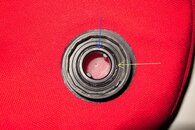Today I inflated a new OMS wing. It held the pressure ok but after 5 mins, you could feel it wasn't as ridge as the beginning. Some minor air leak was evident.
I then put the inflated wing into a tub of water and found some bubbles coming out from the OPV.
I took it open and found the following:

The yellow arrow is pointing to a fine ridge. In my other wings (which hold pressure for weeks), this ridge makes contact with the rubber pad which in turn connected to the pull-cord. The fine ridge and the rubber pad make an air-tight seal under the spring pressure.
However, in this OMS wing, the ridge is actually lower than the thicker ring (indicated by the blue arrow). Therefore, the part making contact with the rubber pad is actually this thick ring and not the fine ridge. This is confirmed by the slightly impression of the thicker ring on the rubber pad if you inspect the pad. I believe this does not create the correct sealing and hence the leak. Am I correct?
I then put the inflated wing into a tub of water and found some bubbles coming out from the OPV.
I took it open and found the following:

The yellow arrow is pointing to a fine ridge. In my other wings (which hold pressure for weeks), this ridge makes contact with the rubber pad which in turn connected to the pull-cord. The fine ridge and the rubber pad make an air-tight seal under the spring pressure.
However, in this OMS wing, the ridge is actually lower than the thicker ring (indicated by the blue arrow). Therefore, the part making contact with the rubber pad is actually this thick ring and not the fine ridge. This is confirmed by the slightly impression of the thicker ring on the rubber pad if you inspect the pad. I believe this does not create the correct sealing and hence the leak. Am I correct?



